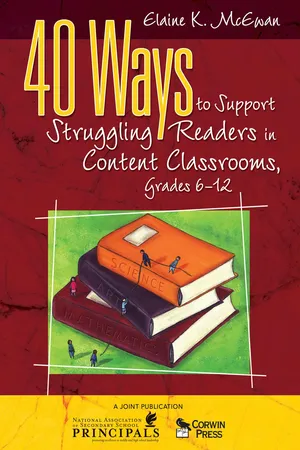
eBook - ePub
40 Ways to Support Struggling Readers in Content Classrooms, Grades 6-12
This is a test
- 200 pages
- English
- ePUB (mobile friendly)
- Available on iOS & Android
eBook - ePub
40 Ways to Support Struggling Readers in Content Classrooms, Grades 6-12
Book details
Table of contents
Citations
About This Book
Provides 40 research-based methods with suggestions for easy implementation to help struggling readers, and features three tables of contents (traditional, topical, and problem-solving) formatted for quick reference.
Frequently asked questions
At the moment all of our mobile-responsive ePub books are available to download via the app. Most of our PDFs are also available to download and we're working on making the final remaining ones downloadable now. Learn more here.
Both plans give you full access to the library and all of Perlego’s features. The only differences are the price and subscription period: With the annual plan you’ll save around 30% compared to 12 months on the monthly plan.
We are an online textbook subscription service, where you can get access to an entire online library for less than the price of a single book per month. With over 1 million books across 1000+ topics, we’ve got you covered! Learn more here.
Look out for the read-aloud symbol on your next book to see if you can listen to it. The read-aloud tool reads text aloud for you, highlighting the text as it is being read. You can pause it, speed it up and slow it down. Learn more here.
Yes, you can access 40 Ways to Support Struggling Readers in Content Classrooms, Grades 6-12 by Elaine K. McEwan-Adkins in PDF and/or ePUB format, as well as other popular books in Education & Teaching Methods for Reading. We have over one million books available in our catalogue for you to explore.
Information
Table of contents
- Cover
- Title Page
- Copyright
- Table of Contents
- Problem-Solution: Table of Contents
- Topical: Table of Contents
- List of Instructional Aids
- Preface
- Acknowledgments
- About the Author
- 1. Teach the Seven Strategies of Highly Effective Readers
- 2. Engage in Teacher and Student Think-Alouds Daily
- 3. Teach Students How to Activate Prior Knowledge and Make Connections to New Knowledge
- 4. Teach Students How to Infer
- 5. Teach Students How to Monitor Their Comprehension
- 6. Teach Students How to Ask Questions
- 7. Teach Students How to Question the Author
- 8. Teach Students How to Search and Select
- 9. Teach Students How to Summarize
- 10. Teach Students How to Graphically Organize Text and Concepts by Chunking
- 11. Use and Teach Concept Maps
- 12. Teach Students How to Mark Text as They Read
- 13. Provide Advance Organizers Before Lessons
- 14. Use the I Do It, We Do It, You Do It Lesson Plan
- 15. Provide Models, Examples, and Nonexamples
- 16. Preview and Preteach Critical Concepts and Vocabulary
- 17. Check Frequently for Understanding
- 18. Assess for Learning and for Grading
- 19. Use and Teach Content Vocabulary Daily
- 20. Teach Academic Vocabulary
- 21. Teach Vocabulary Using Graphic Organizers
- 22. Reduce the Cognitive Load
- 23. Teach the Structure of Your Discipline
- 24. Use Easy Nonfiction to Build Background Knowledge
- 25. Determine What's Hard for Students and Teach It
- 26. Provide Easy-to-Read Short Articles Based on Content Standards
- 27. Assign Oral-Assisted Repeated Reading of Content Text
- 28. Use a Variety of Oral Reading Approaches
- 29. Vary Your Models, Moves, and Activities
- 30. Design Interactive Lessons
- 31. Use the Cooperative Learning Model
- 32. Create Content-Based Cooperative Games and Activities
- 33. Vary Your Seating and Grouping Arrangements
- 34. Give Students Reasons for Reading
- 35. Develop and Use Scoring Rubrics
- 36. Increase Wait Time
- 37. Build In Frequent Processing Breaks
- 38. Use and Teach Mnemonic Devices
- 39. Schedule Writing in Response to Reading on a Regular Basis
- 40. Expect Students to Activate, Connect, and Summarize Daily
- Conclusion
- References
- Index